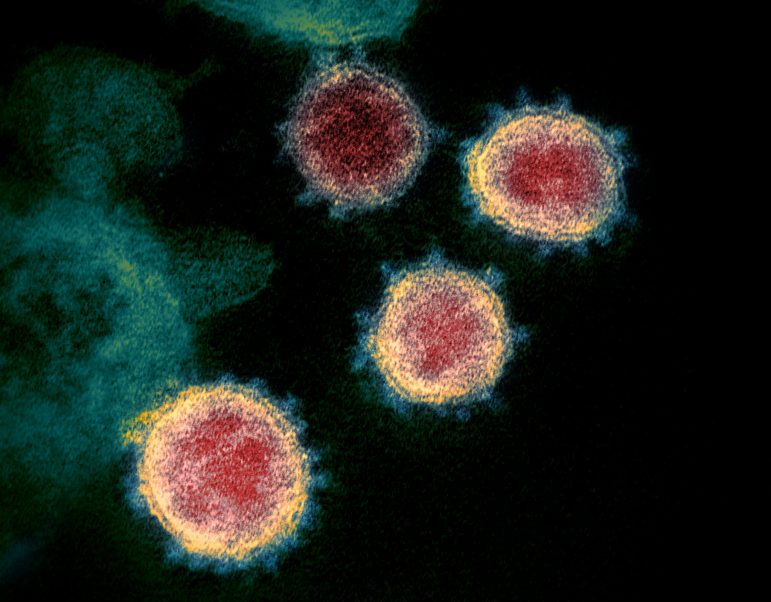The Pennsylvania Department of Health shared its latest data on the spread of the novel coronavirus (COVID-19) in the commonwealth Tuesday at noon, reporting that another 1,579 residents have been diagnosed with the illness and that 78 more people have died from it since Monday.
To date a total of 14,559 cases have been confirmed statewide and 240 Pennsylvanians have died from COVID-19, according to the Department of Health.

A microscopic view of the SARS-CoV-2 virus, which is also known as COVID-19 and colloquially as the novel coronavirus.
The increase in the total number of cases since Monday was about 12.2 percent, which could be a sign that the disease’s spread is beginning to plateau. However, state health secretary Dr. Rachel Levine has so far said it is still too early to determine whether the peak of the proverbial bell curve that reflects COVID-19’s spread is being flattened thanks to statewide containment and mitigation efforts that began in earnest several weeks ago; efforts that have resulted in the temporary closure of non-essential businesses and last week included a request by Gov. Tom Wolf that all residents wear masks while out in public.
A four-county area in northeastern Pennsylvania that Levine said Monday is of concern because of the speed at which case totals have been increasing across it saw its total number of cases increase by about 11.74 percent Tuesday. Philadelphia–which has the most cases among the state’s 67 counties, with more than 4,000 confirmed as of Tuesday–similarly saw its total number increase by approximately 11.1 percent.
However the four “collar counties” between Philadelphia and the Lehigh Valley–Bucks, Montgomery, Delaware and Chester–saw a large spike in their total number of cases, which combined increased from 2,463 to 3,282 on Tuesday. The 819 additional cases represented an increase of approximately 33.3 percent across those counties.
It is unclear what could account for the sudden surge in the number of confirmed cases in the Philadelphia suburbs, but state health officials have warned of the potential for virus ‘hotspots’ or ‘hot zones’ to continue to emerge. Those zones are loosely defined as areas in which caseloads are determined to be increasing at rates that are exponentially higher than in surrounding communities.
It is also unclear what might account for the unusually large (nearly 50 percent) increase in the total number of deaths reported in Pennsylvania between Monday and Tuesday.
Per capita, Pennsylvania has a lower number of cases and deaths than two neighboring states which have been particularly hard-hit by the virus: New Jersey and New York.
According to the data compiled by Worldometer, the total number of cases in Pennsylvania per million residents is 1,138; considerably less than those values in New York (7,077) and New Jersey (5,001). Pennsylvania has reported 19 deaths per million residents from the coronavirus while New Jersey has reported 139 deaths per million residents and New York–which is the epicenter of the outbreak in the United States–had 280 deaths per million residents as of Tuesday.
Pennsylvania, however, is also testing fewer residents than its neighbors, New York and New Jersey.
According to the data, the state has conducted fewer than 100,000 tests within a potential testing pool of more than 12 million residents. Statistically, Pennsylvania has conducted 7,136 tests per million residents, as opposed to New York which has conducted testing at more than double Pennsylvania’s rate (16,353 tests per million residents) and New Jersey (10,693 tests per million residents).
As of Tuesday, New York state had reported 138,836 confirmed cases of the coronavirus and 6,920 deaths, while New Jersey had reported 44,416 cases of the virus and 1,232 deaths.
Nationwide, as of Tuesday at approximately 1:30 p.m., there were 385,838 confirmed cases of COVID-19 and 12,227 deaths from it, according to Worldometer data.
As of Tuesday, Northampton County had 774 confirmed cases of the virus and 14 deaths from it, while Lehigh County had 1,146 confirmed cases of the virus and 10 deaths from it, according to Department of Health data. For more information about the deaths that have occurred in Northampton County, click here.
For updates and news about the coronavirus pandemic in Pennsylvania, follow Gov. Wolf on Twitter and visit the Department of Health website, which is updated with new data daily. The Department of Health also shares resources and information via its Twitter feed.







